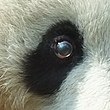Ailuropoda
| Panda | |
|---|---|

| |
| Thegiant panda,the only extant species in the genus and subfamily | |

| |
| Ailuropoda fovealis[clarification needed]skull | |
| Scientific classification | |
| Domain: | Eukaryota |
| Kingdom: | Animalia |
| Phylum: | Chordata |
| Class: | Mammalia |
| Order: | Carnivora |
| Family: | Ursidae |
| Subfamily: | Ailuropodinae |
| Genus: | Ailuropoda Milne-Edwards,1870[1][2] |
| Type species | |
| Ailuropoda melanoleuca | |
| Species | |
Ailuropodais the only extantgenusin theursid(bear)subfamilyAiluropodinae.It contains one living and three fossil species of panda.[4]
Only one species—Ailuropoda melanoleuca—currently exists; the other three species are prehistoricchronospecies.Despite itstaxonomicclassification as acarnivoran,the giant panda has adietthat is primarilyherbivorous,which consists almost exclusively ofbamboo.
Giant pandas have descended fromAilurarctos,which lived during the lateMiocene.[4]
Etymology[edit]

From Greekαἴλουροςaílouros"cat" +‒ποδός‒podós"foot" (gen. sg.). Unlike most bears, giant pandas do not have round pupils, but instead have vertical slits, similar to those of cats. This has not only inspired the scientific name, but in Chinese the giant panda is called "large bear cat" (Gấu trúc,dà xióngmāo).
Classification[edit]
- †Ailuropoda microtaPei, 1962[5][6](latePliocene)
- †Ailuropoda wulingshanensisWang et alii. 1982[7](late Pliocene - earlyPleistocene)
- †Ailuropoda baconi(Woodward 1915)[8](Pleistocene)
- Ailuropoda melanoleuca(giant panda)(David,1869)[3]
- Ailuropoda melanoleuca melanoleuca(David, 1869)
- Ailuropoda melanoleuca qinlingensisWan Q.H., Wu H. et Fang S.G., 2005[9]
Other pandas[edit]
Thered, or lesser, panda(Ailurus fulgens) was formerly considered closely related to the giant panda. It is no longer considered a bear, however, and is now classified as the sole living representative of a different carnivore family (Ailuridae).
References[edit]
- ^Milne-Edwards, Alphonse(1870)."Note sur quelques mammifères du Thibet oriental".Annales des sciences naturelles, Zoologie.Ser. 5.14(10): 1.
- ^Milne-Edwards, Alphonse(1870)."Note sur quelques Mammifères du Thibet oriental".Comptes rendus hebdomadaires des séances de l'Académie des sciences.70:341–342.
- ^abDavid, Armand(1869)."Voyage en Chine".Bulletin des Nouvelles Archives du Muséum.5:13.
Ursus melanoleucus
- ^abJin, Changzhu;Russell L. Ciochon;Wei Dong; Robert M. Hunt Jr.; Jinyi Liu; Marc Jaeger & Qizhi Zhu (June 19, 2007)."The first skull of the earliest giant panda".Proceedings of the National Academy of Sciences.104(26): 10932–10937.Bibcode:2007PNAS..10410932J.doi:10.1073/pnas.0704198104.PMC1904166.PMID17578912.
- ^Pei, Wen-chung(1962)."Guǎngxī liǔchéng jù yuán dòng jí qítā shāndòng de dì sì jì bǔrǔ dòngwù"Quảng Tây Liễu Thành cự vượn động cùng mặt khác sơn động kỷ đệ tứ động vật có vú[Quaternary Mammals from the LiuchengGigantopithecusCave and Other Caves of Kwangsi](PDF).Vertebrata PalAsiatica.6(3): 211–218.
- ^Pei, Wen-Chung(1963)."Quaternary Mammals From the LiuchengGigantopithecusCave and Other Caves of Kwangsi "(PDF).Scientia Sinica.12(2): 221–229. Archived fromthe original(PDF)on 2017-08-21.Retrieved2017-07-20.
- ^Wang, Linghong; Lin, Yufen; Chan, Shaowu; Yuan, Jiarong (1982)."Húnán shěng xīběi bù xīn fāxiàn de bǔrǔ dòngwù huàshí jí qí yìyì"Hồ Nam tỉnh Tây Bắc bộ tân phát hiện động vật có vú hoá thạch và ý nghĩa[Mammalian Fossils Found in Northwest Part of Hunan Province and Their Significance](PDF).Vertebrata PalAsiatica.20(4): 350–358.
- ^Woodward, A. Smith(1915)."On the Skull of an extinct Mammal related toÆluropusfrom a Cave in the Ruby Mines at Mogok, Burma ".Proceedings of the Zoological Society of London.85(III): 425–428.doi:10.1111/j.1469-7998.1915.tb07605.x.
- ^Wan, Qiu-Hong; Wu, Hua; Fang, Sheng-Guo (2005)."A New Subspecies of Giant Panda (Ailuropoda melanoleuca) from Shaanxi, China ".Journal of Mammalogy.86(2): 397–402.doi:10.1644/BRB-226.1.JSTOR4094359.
